tow DODGE SPRINTER 2007 2.G Owner's Manual
[x] Cancel search | Manufacturer: DODGE, Model Year: 2007, Model line: SPRINTER, Model: DODGE SPRINTER 2007 2.GPages: 393, PDF Size: 7.61 MB
Page 176 of 393

175 Operation
Driving tips
4
\3 Driving tipsInformation is available about driving in
winter and with snow chains
(\2page 236).
Transporting your vehicle by rail may be
subject to certain restrictions or require
special measures to be taken in some
countries due to varying tunnel heights
and loading standards.
You can obtain information at any
authorized Sprinter Dealer.Trailer hitches*
Only install a trailer hitch receiver ap-
proved for your vehicle. For information on
availability and installation, please see
your authorized Sprinter Dealer.
The bumpers on your vehicle are not de-
signed for use with clamp-type hitches. Do
not attach rental hitches or other bumper-
type hitches to them.
To reduce the possibility of damage, re-
move the hitch ball adaptor from the re-
ceiver when not in use.Electrical connections*
The Sprinter is available with a variety of
pre-installed conditions (lines and turn sig-
nal indicator and brake module installed
and / or not installed). Make sure that the
correct trailer hitch receiver kit is used. For
further information, please see your autho-
rized Sprinter Dealer.
In order to prevent possible damage to the
vehicle’s electrical system by incorrectly
installing the trailer wiring plug, we recom-
mend having the harness connected at an
authorized Sprinter Dealer.Rail transportTrailer towingWarning
G
Failure to use proper equipment and driving
technique can result in a loss of vehicle con-
trol when towing a trailer.
Improper towing or failure to follow the in-
structions contained in this guide can result
in serious injury.
Follow the guidelines below carefully to as-
sure safe trailer operation.
Ask your authorized Sprinter Dealer if you
require an explanation of information con-
tained in this guide.
Page 177 of 393
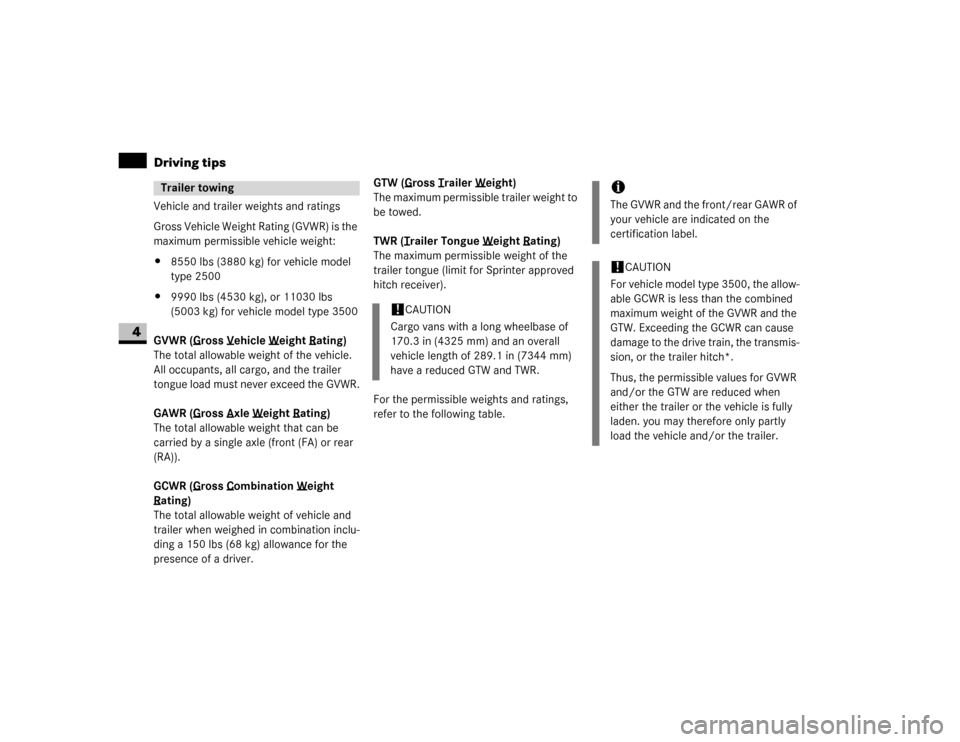
176 OperationDriving tips
4
Vehicle and trailer weights and ratings
Gross Vehicle Weight Rating (GVWR) is the
maximum permissible vehicle weight:
\48550 lbs (3880 kg) for vehicle model
type 2500
\49990 lbs (4530 kg), or 11030 lbs
(5003 kg) for vehicle model type 3500
GVWR (G
ross V
ehicle W
eight R
ating)
The total allowable weight of the vehicle.
All occupants, all cargo, and the trailer
tongue load must never exceed the GVWR.
GAWR (G
ross A
xle W
eight R
ating)
The total allowable weight that can be
carried by a single axle (front (FA) or rear
(RA)).
GCWR (G
ross C
ombination W
eight
R
ating)
The total allowable weight of vehicle and
trailer when weighed in combination inclu-
ding a 150 lbs (68 kg) allowance for the
presence of a driver.GTW (G
ross T
railer W
eight)
The maximum permissible trailer weight to
be towed.
TWR (T
railer Tongue W
eight R
ating)
The maximum permissible weight of the
trailer tongue (limit for Sprinter approved
hitch receiver).
For the permissible weights and ratings,
refer to the following table.
Trailer towing
!
CAUTION
Cargo vans with a long wheelbase of
170.3 in (4325 mm) and an overall
vehicle length of 289.1 in (7344 mm)
have a reduced GTW and TWR.
iThe GVWR and the front/rear GAWR of
your vehicle are indicated on the
certification label.!
CAUTION
For vehicle model type 3500, the allow-
able GCWR is less than the combined
maximum weight of the GVWR and the
GTW. Exceeding the GCWR can cause
damage to the drive train, the transmis-
sion, or the trailer hitch*.
Thus, the permissible values for GVWR
and/or the GTW are reduced when
either the trailer or the vehicle is fully
laden. you may therefore only partly
load the vehicle and/or the trailer.
Page 178 of 393
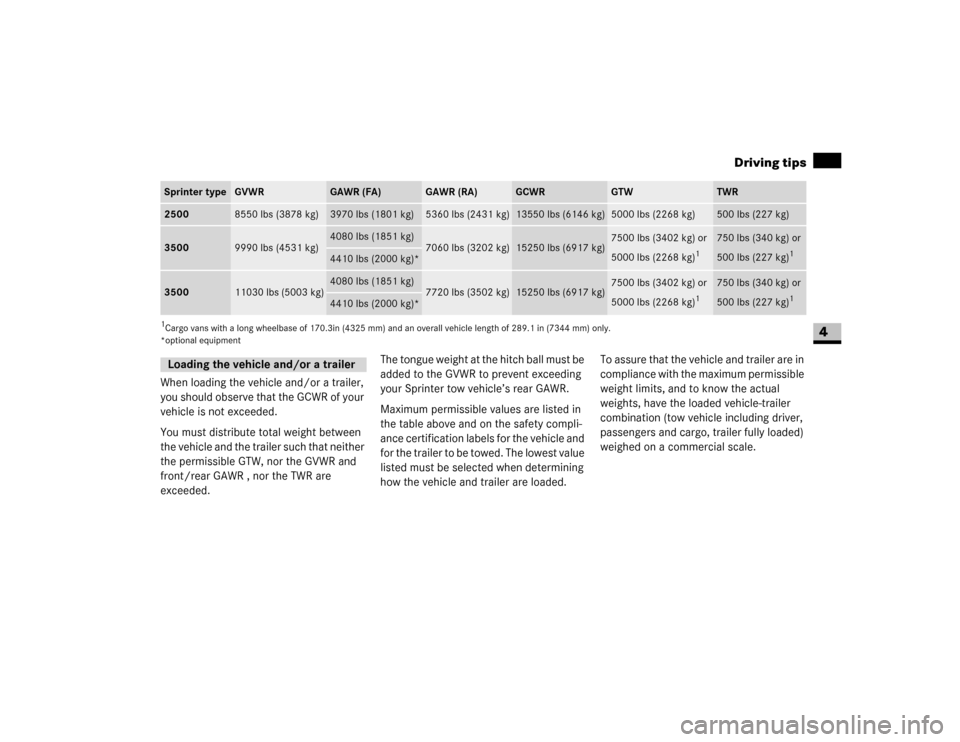
177 Operation
Driving tips
4
1Cargo vans with a long wheelbase of 170.3in (4325 mm) and an overall vehicle length of 289.1 in (7344 mm) only.
*optional equipmentWhen loading the vehicle and/or a trailer,
you should observe that the GCWR of your
vehicle is not exceeded.
You must distribute total weight between
the vehicle and the trailer such that neither
the permissible GTW, nor the GVWR and
front/rear GAWR , nor the TWR are
exceeded.The tongue weight at the hitch ball must be
added to the GVWR to prevent exceeding
your Sprinter tow vehicle’s rear GAWR.
Maximum permissible values are listed in
the table above and on the safety compli-
ance certification labels for the vehicle and
for the trailer to be towed. The lowest value
listed must be selected when determining
how the vehicle and trailer are loaded.To assure that the vehicle and trailer are in
compliance with the maximum permissible
weight limits, and to know the actual
weights, have the loaded vehicle-trailer
combination (tow vehicle including driver,
passengers and cargo, trailer fully loaded)
weighed on a commercial scale.Sprinter type
GVWR
GAWR (FA)
GAWR (RA)
GCWR
GTW
TWR
2500
8550 lbs (3878 kg)
3970 lbs (1801 kg)
5360 lbs (2431 kg)
13550 lbs (6146 kg)
5000 lbs (2268 kg)
500 lbs (227 kg)
3500
9990 lbs (4531 kg)
4080 lbs (1851 kg)
7060 lbs (3202 kg)
15250 lbs (6917 kg)
7500 lbs (3402 kg) or
5000 lbs (2268 kg)
1
750 lbs (340 kg) or
500 lbs (227 kg)
1
4410 lbs (2000 kg)*
3500
11030 lbs (5003 kg)
4080 lbs (1851 kg)
7720 lbs (3502 kg)
15250 lbs (6917 kg)
7500 lbs (3402 kg) or
5000 lbs (2268 kg)
1
750 lbs (340 kg) or
500 lbs (227 kg)
1
4410 lbs (2000 kg)*
Loading the vehicle and/or a trailer
Page 179 of 393
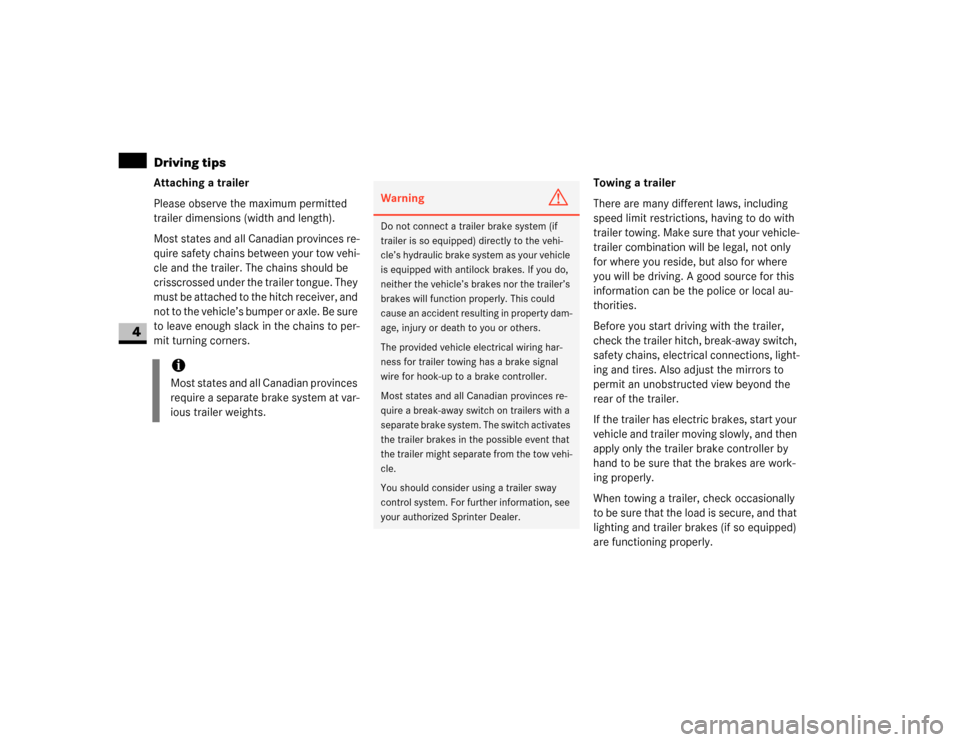
178 OperationDriving tips
4
Attaching a trailer
Please observe the maximum permitted
trailer dimensions (width and length).
Most states and all Canadian provinces re-
quire safety chains between your tow vehi-
cle and the trailer. The chains should be
crisscrossed under the trailer tongue. They
must be attached to the hitch receiver, and
not to the vehicle’s bumper or axle. Be sure
to leave enough slack in the chains to per-
mit turning corners.Towing a trailer
There are many different laws, including
speed limit restrictions, having to do with
trailer towing. Make sure that your vehicle-
trailer combination will be legal, not only
for where you reside, but also for where
you will be driving. A good source for this
information can be the police or local au-
thorities.
Before you start driving with the trailer,
check the trailer hitch, break-away switch,
safety chains, electrical connections, light-
ing and tires. Also adjust the mirrors to
permit an unobstructed view beyond the
rear of the trailer.
If the trailer has electric brakes, start your
vehicle and trailer moving slowly, and then
apply only the trailer brake controller by
hand to be sure that the brakes are work-
ing properly.
When towing a trailer, check occasionally
to be sure that the load is secure, and that
lighting and trailer brakes (if so equipped)
are functioning properly.
iMost states and all Canadian provinces
require a separate brake system at var-
ious trailer weights.
Warning
G
Do not connect a trailer brake system (if
trailer is so equipped) directly to the vehi-
cle’s hydraulic brake system as your vehicle
is equipped with antilock brakes. If you do,
neither the vehicle’s brakes nor the trailer’s
brakes will function properly. This could
cause an accident resulting in property dam-
age, injury or death to you or others.
The provided vehicle electrical wiring har-
ness for trailer towing has a brake signal
wire for hook-up to a brake controller.
Most states and all Canadian provinces re-
quire a break-away switch on trailers with a
separate brake system. The switch activates
the trailer brakes in the possible event that
the trailer might separate from the tow vehi-
cle.
You should consider using a trailer sway
control system. For further information, see
your authorized Sprinter Dealer.
Page 180 of 393

179 Operation
Driving tips
4
Always secure items in the trailer to pre-
vent load shifts while driving.
Take into consideration that when towing a
trailer, the handling characteristics are dif-
ferent and less stable from those when op-
erating the vehicle without a trailer. It is
important to avoid sudden maneuvers.
The vehicle and trailer combination is
heavier, and therefore is limited in acceler-
ation and climbing ability, and requires
longer stopping distances. It is more prone
to reacting to side wind gusts, and requires
more sensitive steering input.
In order to gain skill and an understanding
of the vehicle’s behavior, you should prac-
tice turning , st opping and backing up in a n
area which is free from traffic.
If possible, do not brake abruptly, but rath-
er engage the brake slightly at first to per-
mit the trailer to activate its brake. Then
increase the braking force.
Warning
G
Take into consideration that when towing a
trailer, the handling characteristics are dif-
ferent and less stable from those when op-
erating the vehicle without a trailer.
It is important to avoid sudden maneuvers.
Sudden maneuvers may lead to loss of con-
trol over the vehicle-trailer combination.
This could cause an accident resulting in
property damage or injury to you or others.!
CAUTION
If the transmission hunts between
gears on inclines, manually shift to a
lower gear (select
"4", "3", "2" or
"1").
A lower gear and reduction of speed re-
duces the chance of the engine over-
loading and / or overheating.
When going down a long hill, shift into
a lower gear and use the engine’s brak-
ing effect. Avoid riding the brakes, thus
overheating the vehicle and trailer
brakes.
If the engine coolant rises to an ex-
tremely high temperature (coolant tem-
perature needle approaching the red
zone) when the air conditioner is on,
turn off the air conditioner. Engine
coolant heat can be additionally vented
by opening the windows, switching the
climate control fan speed to high and
setting the temperature control to the
maximum hot position.
Extreme care must be exercised since
your vehicle with a trailer will require
additional passing distance ahead than
when driving without a trailer. Because
your vehicle and trailer is longer than
your vehicle alone, you will also need to
go much farther ahead of the passed
vehicle before you can return to your
lane.
Page 208 of 393

207 Operation
Tires and wheels
4
Step 1
\1Locate the statement “The combined
weight of occupants and cargo should
never exceed XXX kg or XXX lbs.” on
your vehicle’s placard.
Step 2
\1Determine the combined weight of the
driver and passengers that will be
riding in your vehicle.
Step 3
\1Subtract the combined weight of the
driver and passengers from
XXX kilograms or XXX lbs.Step 4
\1The resulting figure equals the avail-
able amount of cargo and luggage load
capacity. For example, if the “XXX”
amount equals 1400 lbs and there will
be five 150 lbs passengers in your vehi-
cle, the amount of available cargo and
luggage load capacity is 650 lbs (1400-
750 (5 x150) = 650 lbs).
Step 5
\1Determine the combined weight of lug-
gage and cargo being loaded on the ve-
hicle. That weight may not safely
exceed the available cargo and luggage
load capacity calculated in step 4.Step 6 (if applicable)
\1If your vehicle will be towing a trailer,
load from your trailer will be trans-
ferred to your vehicle. Consult this
manual to determine how this reduces
the available cargo and luggage load
capacity of your vehicle.
The following table shows examples on
how to calculate total load, cargo load and
towing capacities with varying seating con-
figurations and number and size of occu-
pants. The following examples use a load
limit of 1500 lbs. This is for illustrative
purposes only. Make sure you are using
the actual load limit for your vehicle stated
on the vehicle’s tire and loading informa-
tion placard (\2page 206).
The higher the weight of all occupants, the
less cargo and luggage load capacity is
available.
Page 211 of 393
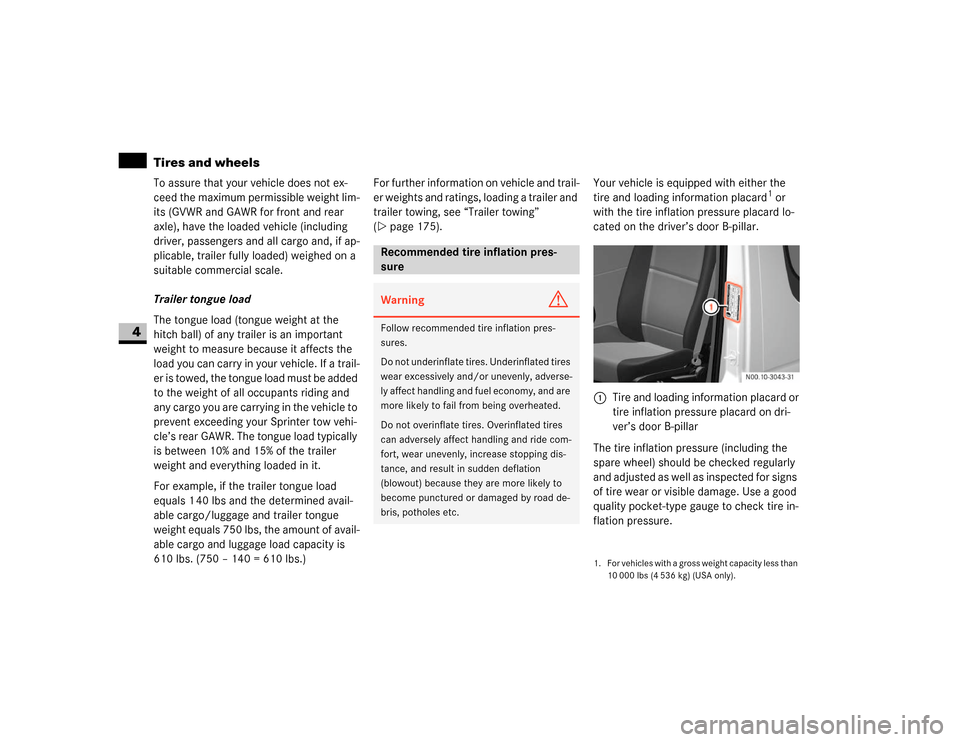
210 OperationTires and wheels
4
To assure that your vehicle does not ex-
ceed the maximum permissible weight lim-
its (GVWR and GAWR for front and rear
axle), have the loaded vehicle (including
driver, passengers and all cargo and, if ap-
plicable, trailer fully loaded) weighed on a
suitable commercial scale.
Trailer tongue load
The tongue load (tongue weight at the
hitch ball) of any trailer is an important
weight to measure because it affects the
load you can carry in your vehicle. If a trail-
er is towed, the tongue load must be added
to the weight of all occupants riding and
any cargo you are carrying in the vehicle to
prevent exceeding your Sprinter tow vehi-
cle’s rear GAWR. The tongue load typically
is between 10% and 15% of the trailer
weight and everything loaded in it.
For example, if the trailer tongue load
equals 1 40 lbs and the determined avail-
able cargo/luggage and trailer tongue
weight equals 750 lbs, the amount of avail-
able cargo and luggage load capacity is
610 lbs. (750 – 140 = 610 lbs.)For further information on vehicle and trail-
er weights and ratings, loading a trailer and
trailer towing, see “Trailer towing”
(\2page 175).Your vehicle is equipped with either the
tire and loading information placard
1 or
with the tire inflation pressure placard lo-
cated on the driver’s door B-pillar.
The tire inflation pressure (including the
spare wheel) should be checked regularly
and adjusted as well as inspected for signs
of tire wear or visible damage. Use a good
quality pocket-type gauge to check tire in-
flation pressure.
Recommended tire inflation pres-
sureWarning
G
Follow recommended tire inflation pres-
sures.
Do not underinflate tires. Underinflated tires
wear excessively and/or unevenly, adverse-
ly affect handling and fuel economy, and are
more likely to fail from being overheated.
Do not overinflate tires. Overinflated tires
can adversely affect handling and ride com-
fort, wear unevenly, increase stopping dis-
tance, and result in sudden deflation
(blowout) because they are more likely to
become punctured or damaged by road de-
bris, potholes etc.
1. For vehicles with a gross weight capacity less than
10 000 lbs (4 536 kg) (USA only).1Tire and loading information placard or
tire inflation pressure placard on dri-
ver’s door B-pillar
Page 242 of 393

241 Operation
Cleaning and care of the vehicle
4
\3 Cleaning and care of the vehicleRegular and proper care will help to main-
tain the value of your vehicle. The best way
to protect your vehicle from harmful envi-
ronmental influences is to wash it and use
protective treatments regularly.
Scratches, corrosive deposits, areas af-
fected by corrosion and damage caused by
neglect or inadequate care cannot always
be completely remedied. In such cases,
visit an authorized Sprinter Dealer.Repair damage caused by loose chippings
and remove the following substances im-
mediately:
\4Insect remains
\4Bird droppings
\4Tree resin
\4Oils and grease
\4Fuel
\4Tar stains
Wash the vehicle more frequently in winter
to remove salt residue.
iIt is recommended that you use Mopar
care products. These have been spe-
cially adapted to Sprinter vehicles and
are state of the art. Mopar care prod-
ucts are available from any authorized
Sprinter Dealer.
Warning
G
Always follow the instructions for using the
care products.
Always keep care products sealed and out
of the reach of children.
Do not use fuel as a cleaning agent. Fuel is
flammable and constitutes a health hazard.
Environmental note
H
Only clean the vehicle in a suitable place for
washing vehicles. Dispose of empty contain-
ers and used cleaning materials in an envi-
ronmentally responsible manner.iIf you need to clean the areas towards
the top of the vehicle, always use
\4suitable ladders
\4secure steps!
CAUTION
Under no circumstances should you af-
fix unsuitable stickers, films, magnets
or similar to painted surfaces. You
could otherwise damage the paint-
work.
Page 250 of 393
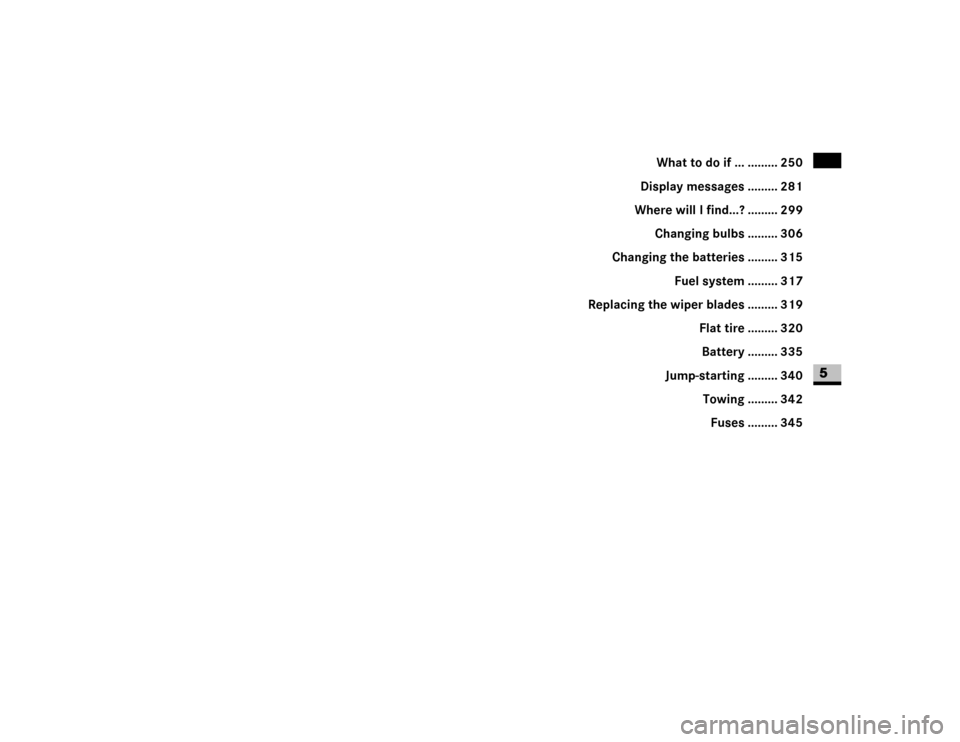
249
5 Practical hints
What to do if ... ......... 250
Display messages ......... 281
Where will I find...? ......... 299
Changing bulbs ......... 306
Changing the batteries ......... 315
Fuel system ......... 317
Replacing the wiper blades ......... 319
Flat tire ......... 320
Battery ......... 335
Jump-starting ......... 340
Towing ......... 342
Fuses ......... 345
Page 261 of 393
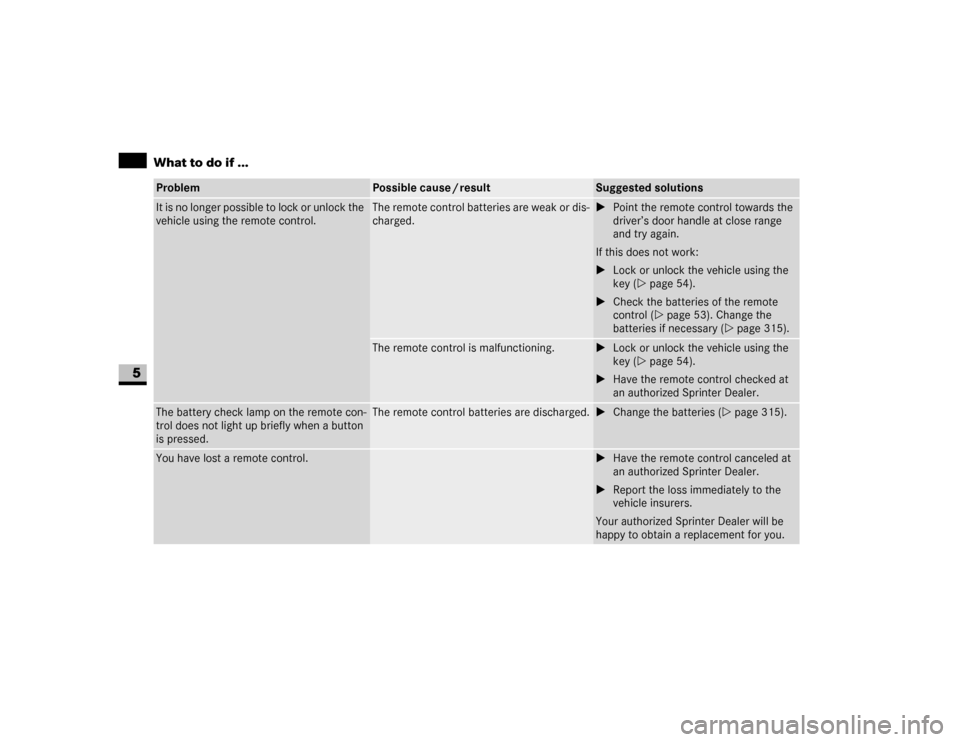
260 Practical hintsWhat to do if ...
5
It is no longer possible to lock or unlock the
vehicle using the remote control.
The remote control batteries are weak or dis-
charged.
\1Point the remote control towards the
driver’s door handle at close range
and try again.
If this does not work:
\1Lock or unlock the vehicle using the
key (\2page 54).
\1Check the batteries of the remote
control (\2page 53). Change the
batteries if necessary (\2page 315).
The remote control is malfunctioning.
\1Lock or unlock the vehicle using the
key (\2page 54).
\1Have the remote control checked at
an authorized Sprinter Dealer.
The battery check lamp on the remote con-
trol does not light up briefly when a button
is pressed.
The remote control batteries are discharged.
\1Change the batteries (\2page 315).
You have lost a remote control.
\1Have the remote control canceled at
an authorized Sprinter Dealer.
\1Report the loss immediately to the
vehicle insurers.
Your authorized Sprinter Dealer will be
happy to obtain a replacement for you.
Problem
Possible cause / result
Suggested solutions